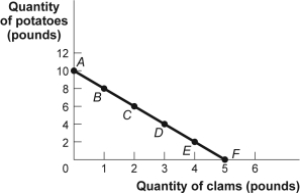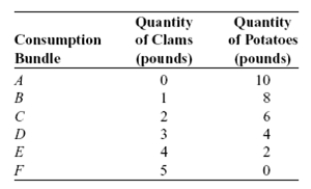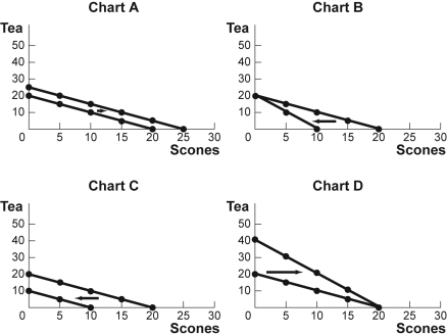A) difference between a firm's total revenue and its total economic cost.
B) good not adequately provided by a free market and usually provided by the government.
C) satisfaction consumers derive from their consumption of goods and services.
D) lowest price that buyers are willing to pay for a given quantity of a good.
F) All of the above
Correct Answer

verified
Correct Answer
verified
Multiple Choice
Use the following to answer questions
Figure and Table: The Budget Line 
 -(Figure and Table: The Budget Line) Look at the figure and table The Budget Line. _____ in the price of clams would rotate the budget line along the _____ axis _____ the origin.
-(Figure and Table: The Budget Line) Look at the figure and table The Budget Line. _____ in the price of clams would rotate the budget line along the _____ axis _____ the origin.
A) An increase; horizontal; toward
B) A decrease; horizontal; toward
C) An increase; vertical; toward
D) A decrease; vertical; away from
F) A) and D)
Correct Answer

verified
Correct Answer
verified
Multiple Choice
Chuck spends all of his income on tacos and milkshakes. His income is $100, the price of tacos is $10, and the price of milkshakes is $2. Put tacos on the horizontal axis and milkshakes on the vertical axis. The vertical for Chuck's budget line is _____ milkshakes.
A) 50
B) 10
C) 5
D) 100
F) A) and C)
Correct Answer

verified
Correct Answer
verified
Multiple Choice
How much _____ Susan obtains from eating green beans is a measure of the utility of green beans for her.
A) efficiency
B) usefulness
C) cost
D) satisfaction
F) C) and D)
Correct Answer

verified
Correct Answer
verified
Multiple Choice
To say that you can't have too much of a good thing means that for any good that you enjoy (for example, pizza) :
A) higher consumption will always lead to higher utility.
B) higher consumption will cause utility to decrease at an increasing rate.
C) higher consumption will increase utility, but only up to a point; after that utility will start to decrease.
D) it is valid to measure utility in utils.
F) B) and D)
Correct Answer

verified
Correct Answer
verified
Multiple Choice
The utility of a good is determined by how much _____ a particular consumer obtains from it.
A) satisfaction
B) usefulness
C) cost
D) need fulfillment
F) A) and B)
Correct Answer

verified
Correct Answer
verified
Multiple Choice
Suppose bad weather and pollution dramatically reduce the supply of crawfish in Louisiana next year. This would most likely lead to _____ in the marginal utility of crawfish consumption.
A) an increase
B) a decrease
C) no change
D) substitution and income effects
F) All of the above
Correct Answer

verified
Correct Answer
verified
Multiple Choice
Chuck spends all of his income on tacos and milkshakes. His income is $100, the price of tacos is $10, and the price of milkshakes is $2. If the price of each good doubles and Chuck's income doubles:
A) Chuck's budget line will be unaffected.
B) Chuck's budget line will shift out.
C) Chuck's budget line will shift in.
D) Chuck will be able to buy more of both goods.
F) B) and C)
Correct Answer

verified
Correct Answer
verified
Multiple Choice
Use the following to answer questions Scenario: Tom's Budget Constraint Tom is trying to decide how to allocate his $50 budget for music downloads and online movie streaming when the price of a music download is $1 and the price of a movie is $5. -(Scenario: Tom's Budget Constraint) Read the scenario Tom's Budget Constraint. The combination _____ music downloads and _____ movies lies ON Tom's budget line.
A) 50; 10
B) 50; no
C) no; 5
D) 100; 5
F) C) and D)
Correct Answer

verified
Correct Answer
verified
Multiple Choice
The amount by which an additional unit of a good or service changes a consumer's total satisfaction, all other things unchanged, is _____ utility.
A) marginal
B) maximum
C) average
D) required
F) None of the above
Correct Answer

verified
Correct Answer
verified
Multiple Choice
On a sparsely populated island, high-speed Internet service would have a _____ marginal utility than in New York City, while in New York City quiet evenings would carry a _____ marginal utility than on a deserted island.
A) lower; higher
B) higher; lower
C) lower; lower
D) higher; higher
F) None of the above
Correct Answer

verified
Correct Answer
verified
Multiple Choice
Use the following to answer questions
Figure and Table: The Budget Line 
 -(Figure and Table: The Budget Line) Look at the figure and table The Budget Line. _____ in the price of clams would rotate the budget line along the _____ axis _____ the origin.
-(Figure and Table: The Budget Line) Look at the figure and table The Budget Line. _____ in the price of clams would rotate the budget line along the _____ axis _____ the origin.
A) An increase; horizontal; away from
B) A decrease; horizontal; away from
C) An increase; vertical; toward
D) A decrease; vertical; away from
F) B) and D)
Correct Answer

verified
Correct Answer
verified
Multiple Choice
Use the following to answer questions
Figure: Budget Lines for Tea and Scones  -(Figure: Budget Lines for Tea and Scones) Look at the figure Budget Lines for Tea and Scones. For months now, Agnes has had $20 per month to spend on tea and scones. The price of each cup of tea and each scone has been $1. Which of the charts shows what will happen to her budget line if the price of both a cup of tea and a scone increase to $2?
-(Figure: Budget Lines for Tea and Scones) Look at the figure Budget Lines for Tea and Scones. For months now, Agnes has had $20 per month to spend on tea and scones. The price of each cup of tea and each scone has been $1. Which of the charts shows what will happen to her budget line if the price of both a cup of tea and a scone increase to $2?
A) A
B) B
C) C
D) D
F) A) and D)
Correct Answer

verified
Correct Answer
verified
Multiple Choice
Economists identify the satisfaction a person derives from the consumption of goods and services as:
A) happiness.
B) usefulness.
C) utility.
D) pleasure.
F) C) and D)
Correct Answer

verified
Correct Answer
verified
Multiple Choice
In economics, the ability of pumpkin pie to satisfy a want is referred to as its:
A) utility.
B) usefulness.
C) worthiness.
D) necessity.
F) A) and B)
Correct Answer

verified
Correct Answer
verified
Multiple Choice
An individual gets 5 units of utility from one slice of pizza and 9 units of utility from two slices of pizza. The principle of diminishing marginal utility implies that the total utility from three slices of pizza will be _____ units of utility.
A) exactly 12
B) less than 13
C) less than 9
D) more than 14
F) A) and C)
Correct Answer

verified
Correct Answer
verified
Multiple Choice
Economists describe the satisfaction consumers receive from consuming goods and services as:
A) utility.
B) income effects.
C) budget constraints.
D) substitution effects.
F) None of the above
Correct Answer

verified
Correct Answer
verified
Multiple Choice
Whatever the relevant time, Molly's spending will be _____ by her _____.
A) unlimited; marginal utility
B) limited; marginal utility
C) limited; budget
D) unlimited; budget
F) A) and D)
Correct Answer

verified
Correct Answer
verified
Multiple Choice
Which of the following goods is MOST likely to display increasing marginal utility over some range?
A) chicken during the 1920s, when it was considered a luxury good
B) paint, because you need enough to paint at least one entire room
C) lobsters, which are so expensive that you must eat two to get your money's worth
D) peanut butter and jelly sandwiches
F) B) and C)
Correct Answer

verified
Correct Answer
verified
Multiple Choice
The relation between an individual's consumption bundle and her satisfaction is called a _____ function.
A) demand
B) production
C) consumption
D) utility
F) C) and D)
Correct Answer

verified
Correct Answer
verified
Showing 21 - 40 of 44
Related Exams